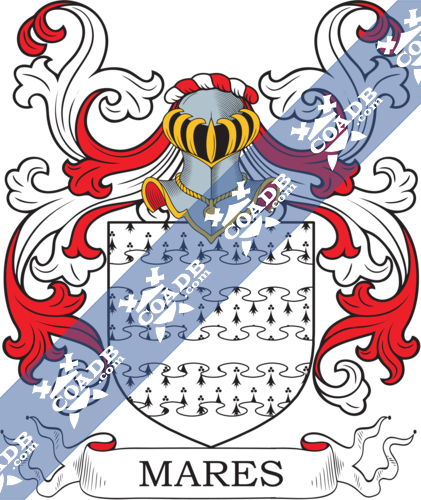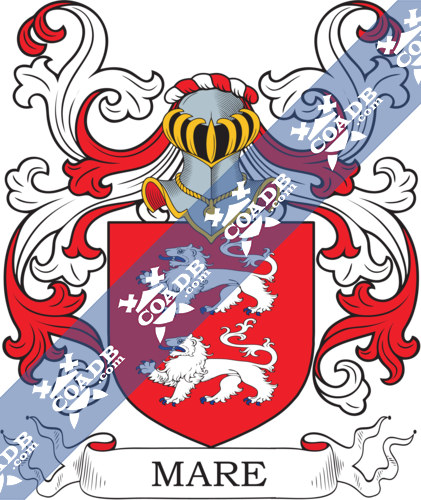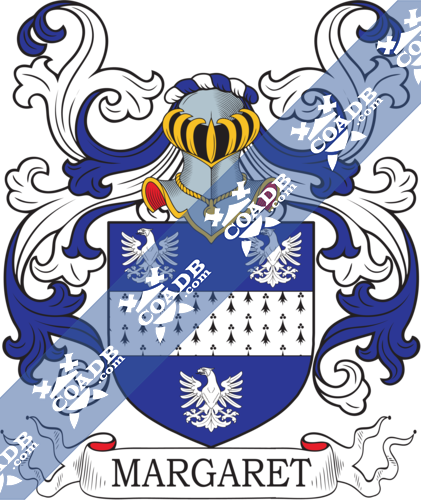Mares Family Crest, Coat of Arms and Name History

Mares Coat of Arms Gallery
Don’t know which Coat of Arms is yours?
We can do a genealogical research. Find out the exact history of your family!
Learn MoreMARES
The surname Mares originates from several sources. The first is geographical in origin, coming from the Catalan region of Spain, it translates to mean “by the sea”. The second source is also geographic, coming from the French “marais” which translates to marsh, from this the Anglicized Mares was derived. The remaining two sources of origin are metronymic or patronymic, the Dutch variation comes from the personal name Marie and the Czech or Slovak variation derives from the given name, Marek or Martin.
There often exists variations in spelling of many surnames, as with many given names which date back to the early centuries. The variation in spelling of both given and surnames during this time period can be attributed to a lack of continuity regarding guidelines for spelling which was compounded by the diversity of languages in use in European countries at this time. The variations in the spelling of the surname Mares include but not limited to; Marais; Mareys; Marets; Marays; Marrey; Du Mares; and Du Marest among others.
The earliest record of any variation of this surname is that of William de Mar which appears in official documents dated 1235 housed at Kelso Abbey. The task of record keeping was primarily under the jurisdiction of the Church, local priories, and government offices. This was due in large part to the fact that literacy was a skill usually found only among the nobles, the clergy, and government officials and scribes.
Surnames in Europe prior to the mid-sixteenth century were largely unheard of. Residents found little need for surnames in the small settlements and villages which existed during earlier times as everyone in these communities new each other and a given name would usually suffice. However, with the passage of time, population growth and expansions of communities as villages gave way to towns and cities, it became necessary to add a qualifier to a people’s names to distinguish them, one from another. Therefore one person may have been identified by their given name plus their occupation while another may have been identified by their given name and one of their parent’s names. There was a limitless supply from which surnames could be culled, in addition to the use of patriarchal or matriarchal names or reference to the individuals occupation, there were things such as defining physical traits, a familiar geographical location or a topographical landmark found near the individuals home or birthplace, the name of the village in which the person lived, and so much more. Soon, surnames would come not just to represent an individual but whole families.
After the discovery of America and the addition to the British Commonwealth of countries such as Canada, Australia, and New Zealand, it was not long before people began to immigrate to these outlying areas. Some of the first recorded immigrants to America bearing the surname was Mary Mares who arrived in or around 1650 and settled in Virginia. Anna Mares landed and settled in Virginia in 1635 and John Askew arrived and settled in Maryland in 1654. Francios Mares was an early settler to Canada, landing and settling in Quebec, Montreal in 1655.
Worldwide, the highest concentration of people with the surname Mares are found in Spain, Belgium, Austria, United States, and Serbia. By state, the largest percentile of those with the surname Mares live in New Mexico, Colorado, Nebraska, and Texas.
One of the earliest fore-bearers of any variation of the surname, Earl of Mar, can be found in the Peerage of Scotland, first created in 1014. This Earldom is thought to be the oldesist peerage not only in Great Britain but in the entirety of Europe. The family seat was located at Kildrummy Castle in Aberdeen, Scotland. The ruins of the castle are still visible and open to the public.
Margaret of Mar, 31st Countess of Mar is the current bearer of the Earldom of Mar as well as Clan Chief of Mar. She is a member of Parliament and is an advocate for many charitable and voluntary organizations, using her position to be a voice for their causes.
The heiress presumptive to the Countess’ peerage is her eldest daughter, Helen of Mar, Mistress of Mar.
Blazons & Genealogy Notes
Barry nebulée of six erm. and ar.







